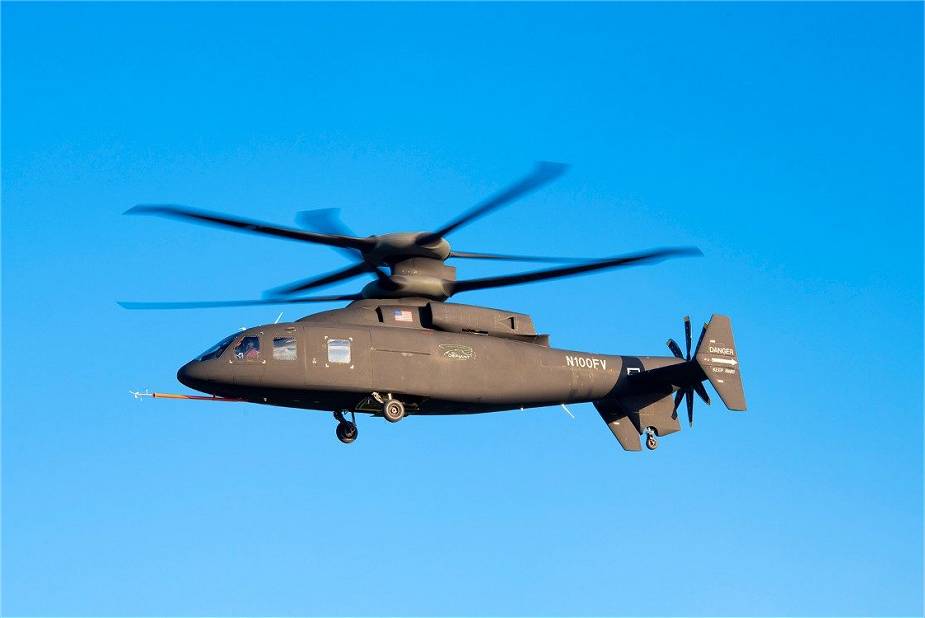Review Part 2 US Army Future Vertical Lift FVL program: SB-1 Defiant Sikorsky-Boeing
Review and analysis by Air Recognition (Subdivision of Army Recognition Group) editorial team about the Future Vertical Lift FVL program of U.S. Army, part 2, the SB-1 Defiant from Sikorsky-Boeing. The Future Vertical Lift (FVL) program is a research and development effort dedicated to discovering, investigating, and refining the technologies that is to provide the next generation of vertical lift aircraft for the United States Armed Forces.
Follow Air Recognition on Google News at this link
 SB-1 Defiant from Sikorsky-Boeing. (Picture source Boeing)
SB-1 Defiant from Sikorsky-Boeing. (Picture source Boeing)
The Air Recognition part 1 review of the Future Vertical Lift FVL program of U.S. Army was dedicated to the Bell Textron V-280 tiltrotor aircraft, in this review we will focus to the SB-1 Defiant developed and designed by the American companies Sikorsky-Boeing. The Sikorsky/Boeing SB-1 is a compound helicopter, using twin coaxial rotors to provide lift and a pusher propeller to enhance speed.
The SB-1 Defiant is jointly produced by the American companies Sikorsky Aircraft and Boeing for the phase one of the FVL program. Originally planned to fly in late 2017, its first flight was delayed in April 2017 to early 2018.
Sikorsky and Boeing have designed the SB-1 DEFIANT to provide the right combination of speed, lift and range that are paramount to both the assault and attack missions while increasing overall maneuverability and agility. Developed with 85 percent commonality between attack and assault aircraft, the SB-1 DEFIANT™ will reduce development and life-cycle costs and ensure minimal disruption or loss of existing rotorcraft expertise. Its open mission systems architecture allows rapid technology and capability insertion to meet evolving FVL requirements and provide the U.S. Military with evolutionary sustainability, affordability and readiness for years to come.
The first prototype was unveiled in December 2018, and the first flight was performed in 2019. Ground runs began in January 2019 with 15 hours of ground tests before the first flight. The first flight took place on 21 March 2019 at Sikorsky West Palm Beach site in Florida.

Main features of SB-1 Defiant from Sikorsky-Boeing. (Picture source Boeing)
The design of SB-1 Defiant looks very similar to the Black Hawk helicopter but it is made of composite materials for achieving superior strength and weight reductions. It also integrates a retractable type landing gear for less drag during flight.
The SB-1 Defiant features the X2 rigid twin coaxial rotor system and a rear propeller for thrust. The X2 Technology™ is designed for speed, maneuverability and scalability. Based on the XH-59A prototype, the Collier Award winning X2 Technology Demonstrator made significant improvements in vibration reduction, weight reduction and blade technology that enables the aircraft to be flown by a single pilot, with a single-engine. With two coaxial rotors on top that rotate in opposite directions, the extra lift from each rotor’s advancing blade balances out the diminished lift from the opposite side’s retreating blade to eliminate retreating blade stall.
To provide the raw forward thrust for fast flight, the back of the SB-1 DEFIANT mounts a pusher propulsor, allowing the aircraft to fly twice as fast and twice as far as today’s conventional helicopter while increasing the overall maneuverability and agility required for specific mission objectives. This additional flight component also provides unique and unmatched maneuverability in all flight regimes including hover, low-speed flight and high-speed flight. According to Sikorsky-Boeing, the new Defiant will be capable of flying at speeds of more than 200 knots, or 230 miles per hour, and maneuvering like a fine-tuned sports car.
The Sikorsky-Boeing SB-1 Defiant can accommodate up to 12 soldiers and four crew members. The internal layout has been designed to offer sufficient space for medical evacuation (MEDIVAC) operations.


























